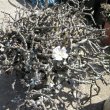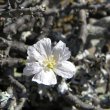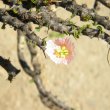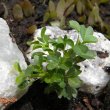| Botanical Name |
|
| Family |
Geraniaceae - The geranium family. |
| Pronunciation |
sar-koh-KAW-lon fun-duh-RIH-tee-ay |
| Common Name(s) |
|
| Plant Group |
- Succulent A plant having fleshy stems or leaves often adapted to dry conditions.
|
| Plant Size |
- Small to Medium
| Tree | 8m to 15m |
| Shrub | 75cm to 1m |
| Perennial/ground cover | 20cm to 40cm |
| Bulb | 30cm to 40cm |
| Succulent | 20cm to 40cm |
- Small
| Tree | 4m to 8m |
| Shrub | 50cm to 75cm |
| Perennial/ground cover | 10cm to 20cm |
| Bulb | 20cm to 30cm |
| Succulent | 10cm to 20cm |
|
| Position |
- Light or Dappled Shade Found below trees with sparse, open foliage. Ideal for the protection of herbaceous plants.
- Partial Shade The area is in shade for part of the day and in full sun for part of the day.
- Sun The area is in full sun for all or most of the day, all year round.
|
| General Information |
- Deciduous Plants which completely lose their foliage for part of the year.
- Drought Tolerance: High The plant is well adapted to arid conditions; it can survive long periods of drought and high temperatures without extra water.
- Frost: Half-hardy The plant is able to survive low temperatures and some frost but requires protection against severe frost.
- Thorns / Spines / Prickles Thorn: A hard, woody, pointed branchlet.
Spine: A modified leaf forming a hard, sharp-pointed outgrowth.
Prickle: A small, sharp-pointed outgrowth growing from the bark of the plant.
- Water Wise Plant species originating from low rainfall regions that require less water to survive and thrive than other plant species.
|
| Specific Information |
Sarcocaulon vanderietiae is a succulent form from the Geranium family. These spiny shrublets have short, fleshy stems and branch just above soil level. The leaves are small and dark green.
|
| Ad Break |
|
| Flowers |
| Description |
five broad, crinkly textured petals in a saucer shape
|
| Season |
- Spring to Summer Plants will seldom bloom for the entire season as given in the list, but should flower during a period within these parameters.
|
| Colour |
|
| Growth Rate |
- Very Slow Specifying growth rate can be very misleading as there is considerable variation of growth rate depending on type and species of plant, available water, supplementary feeding, mulching and general care, as well as the plants suitability and adaptability to the garden environment.
|
| Plant Uses |
- Container Trees, shrubs and ornamental species that can adapt to growing in a restricted environment.
- Pot Plant A plant that needs a protected environment on a patio or indoors.
- Suitable for bonsai A shrub or tree that lends itself to being dwarfed.
- Wild Garden An indigenous garden planted for the benefit of wildlife and birds. Provides food, water, a variety of mini-biomes and no poisonous chemicals are used.
|
| Distribution and Habitat |
up to the Great Fish River in the Eastern Cape, where conditions are dry, on rocky hill- or mountainsides, in gravel and on outcrops of weathered quartzite
|
| Planting Suggestions |
All Sarcocaulons require direct sunlight when in full growth. Plant in very well-drained coarse, sandy or gravelly soil. Do not over-water. Can anyone tell me if they have had success growing Sarcocaulons from cuttings? I am hesitant to cut even a little bit off mine to experiment.
|
| Medicinal Uses |
|
| Ad Break |
|









Comments
sarcocaulon
You asked about cuttings - I found this info on the site below. It may help
Reproduction: There are two main ways to propagate members of the genus Sarcocaulon: Seeds or cuttings. Cuttings often have problems developing a good root structure.
http://www.cactus-art.biz/schede/SARCOCAULON/Sarcocaulon_crassicaule/Sar...
Also, do you have any caudiciform plants available?
Blessings
Sue
Propagating Sarcocaulon
Hi Sue
Thanks for the reference. I met a lady recently who has had some success growing Sarcocaulons from cuttings but she says they take a long time to root (months)and have a low success rate. I also spoke to a ranger at a nature reserve in the Karoo and he explained that cuttings never develop a proper caudex. Last year I was lucky enough to get 3 seeds from my plants. Two germinated but one died. The other one has grown beautifully but needs to be placed into less fertile soil as it is 'over-growing'. I have included a picture of it above.
I have managed to collect very few caudiciform plants and I tend to hog them as they are not easy to come by, costly and grow very slowly. There are some common species like Albuca, Ledebouria, Erythrina and Cussonia that form a caudex and these are available.
If you haven't come across it yet, the following website is also excellent:
http://www.bihrmann.com/caudiciforms/
Regards
Lorraine
caudiciforms
Yes, I have found it
My most comprehensive description of caudicorms and pachycauls is on:
http://davesgarden.com/guides/articles/view/266/#b
The ones you mention, hedebouria I have heard called vermeerbol, but have not found this local name for it on the internet, did not realise it was classified caudiciform
I did not know that the coral trees were classified as caudiciform
And cussonia (cabbage tree) is beautiful, thanks for reminding me
Caudiciform or not caudiciform
What an excellent fount of information. I often use the site but hadn't seen this article - many thanks.
I don't see plants such as Ornithigalum, Albuca and Ledebouria as caudiciforms either. They are epigeal bulbs, but I included them according to Birhmann's site. However the definition in the Dave's Garden article makes it clear that only plants that form a caudex should be included as caudiciforms. I definitely agree with this. Scrap the epigeal bulbs!
I loaded a picture on my site at http://kumbulanursery.co.za/plants/erythrina-humeana, of the caudex of Erythrina humeana. I'm trying these as 'bonsai' although I don't know if the leaves actually reduce in size. The bigger one is about 5 years old and the smaller ones are two years old. The caudex on Cussonias is very similar to these. Now that you have brought this up, I think I need to add more information about these plants to my site.
caudiciforms
coral tree perfect for bonsai - leaves reduce. Go to amazon.com and .uk for 3 books on cauadicforms and pachycauls, kalahari too expensive for same books.
caudiciform and pachycaul
Check the keywords for the search engiens for your site - it took me a few montsh of searching to find your nursery, I have no idea what search word I was suing when I found you. The SA results for caudiciform are poor - teh plantsmen w2ho sell them dont have their sites linked to those words
Findability
Thanks for this Sue. I've been a bit slack on keywords. I have quite a bit of work to do to improve this area and have added it to my list of improvements for the site.
albuca
Forgot to tell you, I know the yellow ones which grow in wcape and west coast as snotlelie or snotblom (just pick it an you know why!), but the internet does not know this common name, just as it does not know vermeerbol!
Albuca
Albuca Nelsonii's common name is Nelson's Slime Lily - enough to put anybody off! There are many plants that have common names that are not generally known. (Out of interest here are 126 species of albuca in South Africa.) Many common names are so localised that they are simply not notarised anywhere. For some other plants however, I have found up to 40 common names.
Thanks for your useful comments.
Lorraine
Discuss this plant
Share knowledge, ask a question or give an experience.